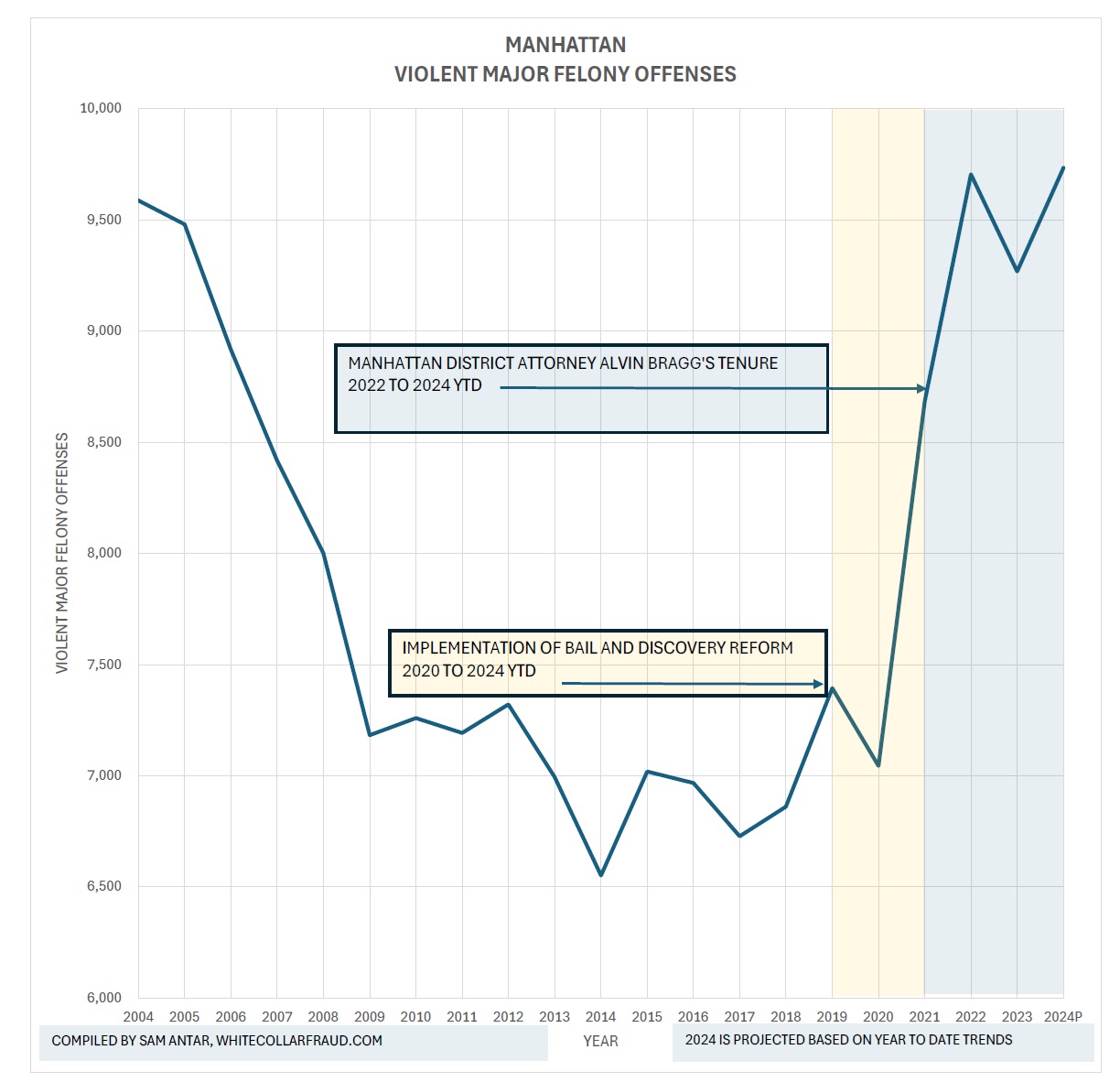Manhattan’s Descent: The Human Cost of Failed Reform
As winter approaches in 2024, Manhattan’s streets tell a story of profound failure. In the gathering darkness of November evenings, grandmothers hurry home earlier, students travel in groups, and store owners eye each passing shadow with growing unease. This isn’t the safer city that District Attorney Alvin Bragg promised when he declared “Safety is paramount” in January 2022. Instead, we face a devastating reality: through November 10, 2024, violent crime continues its relentless climb, erasing two decades of progress and disproportionately devastating our most vulnerable communities.
Two Decades of Progress Erased
The latest NYPD data paints a shocking picture. In just the past four weeks, violent major felonies have surged 12.4% compared to 2023. Behind this stark statistic lies an even darker reality: rape cases have doubled week-over-week, felony assaults have spiked 33.3%, and overall violent crime has jumped 19.2% in just seven days. Each percentage point represents not just a statistic, but a shattered life, a traumatized family, a community living in fear.
2024’s Grim Reality: Violence Soars Under Failed Policies
The year-to-date numbers through Week 45 of 2024 reveal a disturbing pattern of increasing violence since before Bragg took office:
- 4,882 felony assaults in 2024, up 8.1% from 2023 and a shocking 15.7% increase from 2021 (the year before Bragg took office)
- 274 rape cases, a horrifying 24.5% increase over 2023, and 5.8% higher than 2021
- 3,261 robberies, slightly down (-0.4%) from 2023 but still 7.0% higher than 2021’s pre-Bragg levels
- Overall violent major felonies at 8,479 – up 5.0% from 2023 and an alarming 11.5% higher than 2021, the year before this administration took office
Even more alarming, when projected through year-end based on current trends, Manhattan is on pace to reach 9,734 violent major felonies in 2024 – a staggering 31.6% increase from 2019’s pre-bail reform levels. This staggering number demostrates how Bragg’s policies have dramatically accelerated an already troubling trend that began with bail reform
The Failed Promise of Reform
This crisis began on January 1, 2020, with bail and discovery reforms that weakened our criminal justice system. Bragg’s 2022 policies, declining to prosecute certain crimes, accelerated our descent. Today, we’re facing violent crime levels that harken back to 2004, effectively erasing twenty years of progress in public safety.
Communities of Color Bear the Heaviest Burden
Demographic data for the nine months ended September 30, 2024 – the most recent period for which such analysis is available – reveals the devastating inequity in who bears the heaviest burden of this failed experiment in “reform”:
- Black residents face a staggering 10.15 times greater risk of murder than white residents
- Hispanic New Yorkers experience 5.68 times the risk of murder
- Combined, Black and Hispanic communities endure 4.4 times higher risk of violent crime victimization
- Asian and Pacific Islander residents face 3.34 times the risk of robbery
- American Indian/Alaskan Native communities suffer 2.12 times the risk of robbery
The Human Cost: Behind the Numbers
Walk through Harlem, where elderly residents peer anxiously through windows before venturing out. Visit the Lower East Side, where Asian business owners install yet another security camera. Speak to the young Hispanic professional who now carries pepper spray on her commute. These are the real faces behind our climbing crime statistics – the human cost of policies that promised progress but delivered peril.
The Price of Misguided Policy
In just the past 28 days, Manhattan has witnessed 790 violent major felonies – each one a life altered, a family traumatized, a community’s sense of safety further eroded. The Police Benevolent Association’s prescient 2022 warning has become our reality: too many now believe they can commit crimes with zero consequences.
The data through November 10 reveals the cruel irony: reforms intended to create a more equitable justice system have instead left our most vulnerable communities facing dramatically increased risks of violent victimization. When politicians downplay these trends or dismiss them as “fear-mongering,” they betray the very communities they claim to serve.
A Call for Change
As 2024 draws to a close, Manhattan stands at a crossroads. The question isn’t whether these reforms have failed – the numbers sourced directly from NYPD through Open Data and CompStat 2.0 speak with crystal clarity. The question is whether we have the courage to admit this failure and return to the policies that once made New York a model for urban safety.
Until then, each sunset brings deeper shadows of uncertainty, particularly for our communities of color who bear the heaviest burden of this failed experiment in “reform.” This is the true cost of our current policies – not just in numbers, but in the fundamental right of every New Yorker, regardless of race or ethnicity, to feel safe in their own city.
Tonight, somewhere in Manhattan, another victim will join our statistics. Another family will feel the impact of our failed policies. Another community will question why we abandoned what worked for what sounded good. The time for change isn’t coming – it’s already tragically overdue.
Written by Sam Antar
© 2024 Sam Antar. All rights reserved.
All crime statistics cited in this essay are sourced from NYPD through Open Data and CompStat 2.0 through November 10, 2024 (Week 45). Demographic risk analysis covers the nine-month period ended September 30, 2024.


